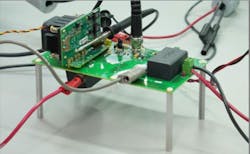Texas Instruments recently expanded its high-voltage power management portfolio with next-generation 650- and 600-V gallium-nitride (GaN) field-effect transistors (FETs) for automotive and industrial applications. Integrating a 2.2-MHz integrated gate driver, the devices can enable twice the power density, achieve up to 99% efficiency, and reduce the size of power magnetics by up to 59% compared to existing solutions.
Developed using proprietary materials and processing with a GaN-on-silicon (Si) substrate, these GaN FETs can address applications from driving electric-vehicle (EV) onboard chargers to empowering hyperscale and enterprise computing platforms. To get a better handle on what this represents for the engineering community, we sat down with Steve Tom, who manages the GaN product line within TI’s High-Voltage Power business unit. Steve joined TI after graduating from the University of Michigan with BSEE and MS IOE degrees.
Let's start with the trends in wide-bandgap power electronics, because in this case, talking about the trends is a good place to start.
I think sometimes we take power management for granted because everything needs power. And that's why we’re so focused on it—it’s that important. We want our customers to make the most differentiated products. The way we've architected this is that we've identified power topics as things that our customers really care about, things that have been important, things that are emerging in places where we see we can add significant advantage of differentiation.
Everybody's been talking about power density and efficiency, but let’s talk about something we don't often see, and that's TI touting the isolation and low noise of these parts.
I spent a lot of time myself personally addressing power density, but the key is the isolation technology. If you've got to shift domains in the voltage, you have to have an isolation barrier. I live on the high-voltage side of the transformer; you have to be able to cross over the appropriate way to get to whatever you're trying to power.
So, isolation's important for that. It's also important in a lot of the topologies we do with GaN. The reason GaN can provide the power density and efficiency is because we use new topologies. Those topologies also require isolation, so that’s the place we're able to merge in with different technologies.
Thanks for addressing that, because the two things you most often hear are power density and how the frequencies are so high. They're so astronomically high that your magnetics can be the size of a match head. That's all you hear. You know what I mean? And it's nice to hear other aspects of the advantages of the technology.
You have to talk about low noise and precision. To get the performance, you're pushing a lot of power, and you can deliver that efficiency. But if you can't control it with precision, you can't get the right switching waveforms. If you're just blasting the device, it's going to lead to trouble. The key is, you have to get those ideal waveforms because if you get clean square waveforms, you're not burning efficiency and seeing parasitic ringing.
We focused on integrating the driver to get the highest DVT, because if you have slow DVT, you're just burning power. By putting a silicon driver with our GaN FET, you get that brawn of GaN, but you also get the brains and the precision of a silicon driver, so you're getting the best of both worlds. When thinking about power, if you want to optimize and deliver properly, having analog high-precision circuits to give you that low-noise capability allows you to get the most out of what you're trying to deliver. And hence the reason for TI's focus in this direction.
Which brings me to the next point, because packaging is a significant issue when it comes to wide-bandgap semiconductors. Between the parasitics and the design and all, the current generation of passive and transistor packaging does not hold up to the performance that wide bandgap promises. In your release, you talk about your ultra-cool packaging. So, you're also thinking about thermal as well as parasitics.
It's a hobby of mine, because without the packaging, you can't get the power. And I think if you look at the power levels, the power levels aren't new. People have always been trying to push one, five, 10 kilowatts, or more. Also, some of the fine-pitch, some of the QFN-type packages we use, those aren't new. They've been used in low voltage for a long time.
The high-speed nature has been done for a long time as well. The challenge is, can you get the high power, the high speed, and that fine-pitch packaging, and do it all at the same time? That's what's really new and differentiated with what we're doing. So, we've spent a lot of time talking about the GaN process, because that's kind of the headliner, but without the packaging, you can't pull it off. We never had a TO-220 type of package. We know those big leads at that speed, it's just an inductor. It's just not going to work. We knew that we had to get a different type of package.
That's why we've gone with this kind of QFN style—this low inductance—but at the same point, designed so that you can get the thermal mechanics. You’ve got to get the right size pads. You’ve got to be able to distribute the power where you must get it off the board. You've got to get the heat thing.
We're trying to also come up with packages so that our customers are doing new things. They're having to find ways to think about how to integrate these in, but that's what's exciting about what we're seeing with some of our new parts.
You say reference designs are coming, but what about evaluation kits? I see you have this daughtercard available. Can you talk a little bit about that aspect, what's coming in the way of designs and kits and the like?
We want to get our customers up and running as soon as possible. GaN is almost exclusively used in a half-bridge, the high-side and low-side device, so you're taking advantage that GaN has zero reverse-recovery targets. That allows you to switch fast, which is a big advantage. We focus on the half-bridge. We want to make it so you can basically plug it in. We want to make it versatile. On that daughtercard, we have the two devices, so you have everything you need to get up and running. We optimize the layout; the waveforms are clean.
It basically gives the end user flexibility for any type of motherboard they're working on. If they want to do totem-pole PFCs, or any number of multi-level typologies, or more higher-power advanced typologies, that's your basic sub-building blocks you can plug in. And because the way it was optimized on a car, it gives you flexibility if you need to wire it to do different areas. That was our intent there.
Is the industrial device simply a version of the automotive device, or does it do things differently?
There's a couple of differences. The first is the voltage level. In the automotive device, there's a trend and oftentimes requirement to get to that higher voltage, that 650-V level, versus industrial, where 600 V make sense when a lot of the offline power is power supplies. Both have similar power levels, power delivery.
One of the bigger differences is, as I mentioned before, in the automotive version we put the power pad on top, so you can implement it with a cold plate. The device for industrial use sits in a 1U rack for a telecom or an enterprise PSU. You can put it on a daughtercard and stand it up.
One of the things the release brings up is in integrated high-speed protection and digital temperature reporting for active power management and thermal monitoring. Now, are you using an open-source thing, like a PMBus kind of thing, or is this a proprietary command bus?
There are two specific features. One is the digital temperature reporting. We actually kept it pretty simple for this one—it’s just a simple PWM out, you could run that directly into a micro. It’s proportional to the temperature.
Very straightforward.
We talk about active power management. There's also another feature here. I mentioned we can send the voltage a current, which is useful. So, like a synchronous converter, your current is going to reverse and we can sense that reversal. Whether it's a MOSFET or other GaN FETs, that device will passively conduct current of the reverse direction, but you get that body die out and you burn a lot of power.
If we're testing that current, we just turn the FET back on automatically. And suddenly that power dissipation dropped to near zero because your FET is now back on. The turn on assist, we can call it ideal diode mode or other different ways, but it's that optimal sensing and turn on that you're able to get. Reduce your power dissipation and push your system that much harder.
Is there anything you feel we haven't touched on that you think is important to leave with the audience?
What I would say is it's exciting to see what the technology can do. The end performance—whether it's the power density, whether it's the efficiency, whether it's just reducing thermals—if you can get the efficiency up, you can remove fans in your set of cooling fans. Therefore, you just get an overall simplified system.
That benefit is what's really exciting, and that's what I enjoy seeing as people find different ways to use the parts. I'm just excited that we can be part of it. The implementation we're doing, we take that GaN FET and integrate a high-performance silicon driver to optimize the performance of FET, and we put it in an advanced package that allows you to get thermals out efficiently without compromising electrical performance.
Pricing has become very aggressive—it’s being able to be competitive with existing technologies. So, when we look at it, there's really no reason not to move over to GaN and take advantage of what it can bring in.



